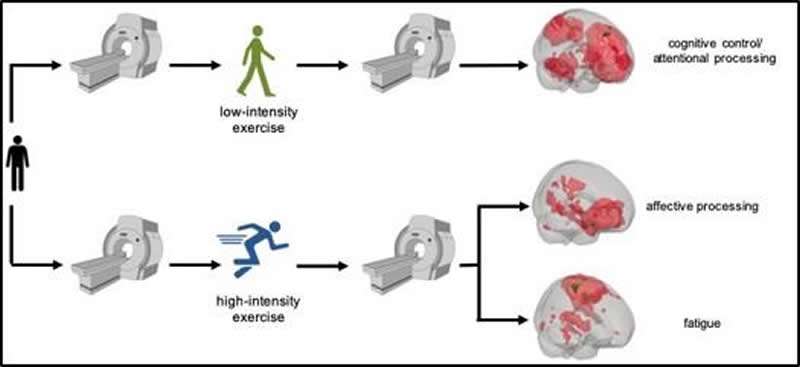Modulation of Distinct Intrinsic Resting State Brain Networks by Acute Exercise Bouts of Differing Intensity.
Angelika Schmitt Brain Plasticity 2020
Acute exercise bouts alter resting state functional connectivity (rs-FC) within cognitive, sensorimotor, and affective networks, but it remains unknown how these effects are influenced by exercise intensity.
Twenty-five male athletes underwent individual fitness assessments using an incremental treadmill test. On separate days, they performed ‘low’ (35% below lactate threshold) and ‘high’ (20% above lactate threshold) intensity exercise bouts of 30 min. Rs-fMRI and Positive and Negative Affect Scale (PANAS) were acquired before and after each exercise bout. Networks of interest were extracted from twenty-two participants (3 dropouts). Pre-to-post changes and between conditions effects were evaluated using FSL’s randomise by applying repeated measures ANOVA. Results were reported at p < 0.05, corrected for multiple comparisons using threshold free cluster enhancement.
PANAS revealed a significant increase in positive mood after both exercise conditions. Significant effects were observed between conditions in the right affective and reward network (ARN), the right fronto parietal network (FPN) and the sensorimotor network (SMN). Pre-to-post comparisons after ‘low’ exercise intensity revealed a significant increase in rs-FC in the left and right FPN, while after ‘high’-intensity exercise rs-FC decreased in the SMN and the dorsal attention network (DAN) and increased in the left ARN.
Supporting recent findings, this study is the first to report distinct rs-FC alterations driven by exercise intensity: (i) Increased rs-FC in FPN may indicate beneficial functional plasticity for cognitive/attentional processing, (ii) increased rs-FC in ARN may be linked to endogenous opioid-mediated internal affective states. Finally, (iii) decreased rs-FC in the SMN may signify persistent motor fatigue. The distinct effects on rs-FC fit with theories of transient persistent network alterations after acute exercise bouts that are mediated by different exercise intensities and impact differentially on cognitive/attentional or affective responses.














